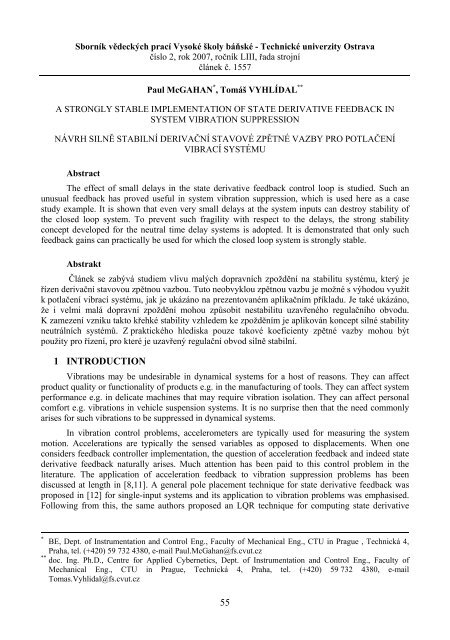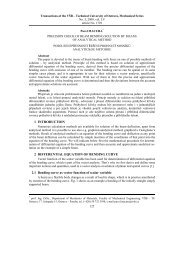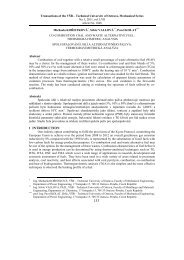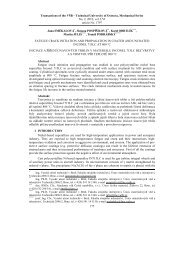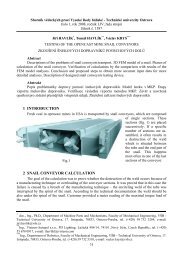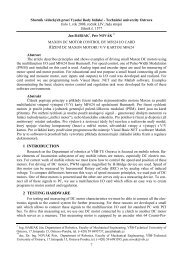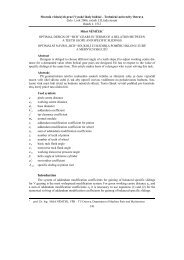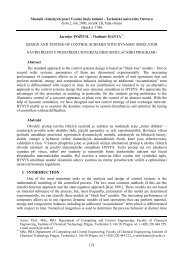SbornÃk vÄdeckých pracà Vysoké Å¡koly báÅské ... - Transactions
SbornÃk vÄdeckých pracà Vysoké Å¡koly báÅské ... - Transactions
SbornÃk vÄdeckých pracà Vysoké Å¡koly báÅské ... - Transactions
Create successful ePaper yourself
Turn your PDF publications into a flip-book with our unique Google optimized e-Paper software.
Sborník vědeckých prací Vysoké školy báňské - Technické univerzity Ostrava<br />
číslo 2, rok 2007, ročník LIII, řada strojní<br />
článek č. 1557<br />
Paul McGAHAN * , Tomáš VYHLÍDAL **<br />
A STRONGLY STABLE IMPLEMENTATION OF STATE DERIVATIVE FEEDBACK IN<br />
SYSTEM VIBRATION SUPPRESSION<br />
NÁVRH SILNĚ STABILNÍ DERIVAČNÍ STAVOVÉ ZPĚTNÉ VAZBY PRO POTLAČENÍ<br />
VIBRACÍ SYSTÉMU<br />
Abstract<br />
The effect of small delays in the state derivative feedback control loop is studied. Such an<br />
unusual feedback has proved useful in system vibration suppression, which is used here as a case<br />
study example. It is shown that even very small delays at the system inputs can destroy stability of<br />
the closed loop system. To prevent such fragility with respect to the delays, the strong stability<br />
concept developed for the neutral time delay systems is adopted. It is demonstrated that only such<br />
feedback gains can practically be used for which the closed loop system is strongly stable.<br />
Abstrakt<br />
Článek se zabývá studiem vlivu malých dopravních zpoždění na stabilitu systému, který je<br />
řízen derivační stavovou zpětnou vazbou. Tuto neobvyklou zpětnou vazbu je možné s výhodou využít<br />
k potlačení vibrací systému, jak je ukázáno na prezentovaném aplikačním příkladu. Je také ukázáno,<br />
že i velmi malá dopravní zpoždění mohou způsobit nestabilitu uzavřeného regulačního obvodu.<br />
K zamezení vzniku takto křehké stability vzhledem ke zpožděním je aplikován koncept silné stability<br />
neutrálních systémů. Z praktického hlediska pouze takové koeficienty zpětné vazby mohou být<br />
použity pro řízení, pro které je uzavřený regulační obvod silně stabilní.<br />
1 INTRODUCTION<br />
Vibrations may be undesirable in dynamical systems for a host of reasons. They can affect<br />
product quality or functionality of products e.g. in the manufacturing of tools. They can affect system<br />
performance e.g. in delicate machines that may require vibration isolation. They can affect personal<br />
comfort e.g. vibrations in vehicle suspension systems. It is no surprise then that the need commonly<br />
arises for such vibrations to be suppressed in dynamical systems.<br />
In vibration control problems, accelerometers are typically used for measuring the system<br />
motion. Accelerations are typically the sensed variables as opposed to displacements. When one<br />
considers feedback controller implementation, the question of acceleration feedback and indeed state<br />
derivative feedback naturally arises. Much attention has been paid to this control problem in the<br />
literature. The application of acceleration feedback to vibration suppression problems has been<br />
discussed at length in [8,11]. A general pole placement technique for state derivative feedback was<br />
proposed in [12] for single-input systems and its application to vibration problems was emphasised.<br />
Following from this, the same authors proposed an LQR technique for computing state derivative<br />
* BE, Dept. of Instrumentation and Control Eng., Faculty of Mechanical Eng., CTU in Prague , Technická 4,<br />
Praha, tel. (+420) 59 732 4380, e-mail Paul.McGahan@fs.cvut.cz<br />
** doc. Ing. Ph.D., Centre for Applied Cybernetics, Dept. of Instrumentation and Control Eng., Faculty of<br />
Mechanical Eng., CTU in Prague, Technická 4, Praha, tel. (+420) 59 732 4380, e-mail<br />
Tomas.Vyhlidal@fs.cvut.cz<br />
55
feedback for multiple-input systems in [1]. The application of state derivative feedback to vibration<br />
problems has also been discussed from the perspective of robust control in [10].<br />
Even when a dynamical system is modelled as ordinary differential equations, it is extremely<br />
important to consider latencies which arise from the application of a control action [6]. Such latencies<br />
can occur due to e.g. computational delays, AD-DA conversion, or communication delays. The role<br />
of latency phenomena on system stability is of crucial importance when one considers systems with<br />
state derivative feedback. It is shown that the application of state derivative feedback renders a<br />
system of the neutral type. This induces complications with respect to system stability due to the fact<br />
that the system may be very sensitive even to infinitessimal delay changes [14]. For this reason, the<br />
notion of strong stability is utilised from [2,3]. This ensures robustness of stability w.r.t. delay<br />
perturbations.<br />
The remainder of the paper is structured as follows: firstly a vibration suppression problem is<br />
presented as a motivating example. Then the pertinent issues of state derivative feedback and neutral<br />
equations are discussed. Finally, a case study is presented where the results of this study are analysed<br />
and compared to those in the literature.<br />
2 CASE STUDY<br />
As the motivation example we adopt the vibration suppression example presented in [1],<br />
which is shown in Fig. 1. A linear state space formulation of the system, with states<br />
, assuming to be small, is given by<br />
(1)<br />
where , , and . and are the mass<br />
and inertia of the mass respectively, and are the spring constants, and are the damping<br />
constants, is the distance between the two supports, is the angle of inclination of the mass with<br />
the horizontal, is the displacement of the centre of the mass, and are the displacements of<br />
the sides of the mass and and are the control inputs. The objective of applying such control<br />
inputs is to interchange or dissipate kinetic and potential energy effectively such that system<br />
vibrations are reduced. One way of achieving this is by altering damping and stiffness characteristics<br />
of the system e.g. and . Alternatively the system actuators (piezo-actuators or linear motors)<br />
controlled by the inputs u can simply displace the system thus counteracting the vibrations present<br />
and setting the system to rest.<br />
x<br />
m, I 2 y<br />
x System parameters:<br />
1<br />
<br />
kg, , ,<br />
, ,<br />
k 2 b 2 k 1<br />
b 1<br />
u 2<br />
2L<br />
u 1<br />
, .<br />
Open loop system poles:<br />
Fig. 1 Scheme and parameters of the vibration suppression example<br />
The design objective is to achieve vibration suppression using a state derivative feedback<br />
controller. In the next section, we provide a short introduction to the theory of state derivative<br />
56
feedback design. Next, we concentrate on the stability consequences of the small uncertain delays<br />
appearing in the state derivative feedback loop.<br />
3 INTRODUCTION TO STATE DERIVATIVE FEEDBACK<br />
Let us consider a system of the form<br />
where is the state and are the inputs. It is assumed that is of full rank, i.e. the<br />
system is state controllable and has no root at origin of the complex plane [1]. It is desired to design a<br />
stabilising controller of the form<br />
The closed loop system then takes the form<br />
The design problem is to compute a feedback gain matrix such that the closed loop poles<br />
are located in the open left half complex plane. This is achieved through a system transformation to<br />
the Frobenius canonical form and by applying a technique similar to that applied in the derivation of<br />
the Ackermann formula for state feedback. For derivations of the Ackermann formula for state<br />
feedback and the equation for state derivative feedback the reader is referred to [9] and [12]<br />
respectively. The formula derived in [12] can be generalised, using work presented in [5] to compute<br />
state derivative feedback gains for MIMO systems.<br />
It is important to note that a relationship can be derived between state feedback and state<br />
derivative feedback. From [1], the following relationship can be derived<br />
So the following relationship can be stated<br />
This is an interesting result considering the fact that algorithms for calculating state feedback gains<br />
are widely available in software packages such as MATLAB [4]. This relationship is used to obtain<br />
the results presented in this work, unless otherwise stated. Obviously, under the condition stated in<br />
the beginning of this section, the dynamics of the system can be assigned by (3) as if the classical<br />
state feedback is used. However, as will be shown in the next section, the state derivative feedback<br />
system (4) can be critically fragile w.r.t. small delays in the feedback loop.<br />
4 THE EFFECT OF SMALL DELAYS IN STATE DERIVATIVE FEEDBACK<br />
In real systems, it is inevitable that small uncertain time delays may occur in the feedback loop<br />
of an applied control algorithm. Recalling equation (1), and rewriting the equation considering such<br />
delays, we obtain the system in the form<br />
(2)<br />
(3)<br />
(4)<br />
(5)<br />
(6)<br />
(7)<br />
where are the delays arising in the feedback loop of the system. The summation over the input<br />
terms is necessary, due to the fact that each individual input may have a corresponding unique delay<br />
value. Now considering the state derivative feedback (3) (for simplicity, we use the notation<br />
), the closed loop system changes from the form (4) to<br />
57
(8)<br />
Let us point out that equation of the form (8) is referred to as a neutral differential equation. A<br />
characteristic of neutral equations is that delays are present in the derivative of the state. Such a<br />
system description induces complications when one considers system stability. The concept of a<br />
strongly stable solution, introduced in [3], must therefore be considered.<br />
4.1 Strong stability of neutral systems<br />
For system (8) we can define the associated difference equation given by<br />
(9)<br />
(8) as<br />
Now, let us define the smallest real upper bound of the infinite spectrum of the neutral system<br />
(10)<br />
where<br />
is the characteristic function of (8). Analogously let us define<br />
(11)<br />
as the smallest real upper bound of the infinite spectrum of the associated difference equation (9),<br />
where is its characteristic function. In both (10) and (11), is a vector of the delays present in<br />
the system, e.g. .<br />
It has been shown in [2, 3] see also [7, 14] that<br />
Therefore, the necessary condition for stability of neutral system (8) is stability of the associated<br />
difference equation (9).<br />
It has also been shown in [2,3], see also [7, 14], that although the smallest upper bound (11) is<br />
continuous in the coefficients of the matrices , it is not continuous in the delays . A major<br />
consequence of this non-continuity is that arbitrarily small delay perturbations may destroy stability<br />
of the difference equation. Thus, the stability for given fixed delays is not sufficient from the<br />
robustness point of view. Therefore the concept of strong stability has been introduced in [2, 3]. It can<br />
be stated that the solution of difference equation (10) is strongly stable if it remains stable when<br />
subjected to small variations in the delays. In [2,3] the criterion for evaluating the strong stability is<br />
derived as follows. The solution of the delay difference equation (10) is strongly stable if and only if<br />
(12)<br />
(13)<br />
As can be seen from (13), the strong stability is independent of the value of the delays. This means<br />
that the stability locally in the delays is equivalent with the stability globally in the delays [2, 3, 14].<br />
58
Let us also remark that if then equation (9) is unstable for rationally independent 1 delays,<br />
[2, 3]. Moreover, in such a case, the closed loop system has infinitely many unstable roots.<br />
5 CASE STUDY RESULTS<br />
In this section, first we study the effects of small delays in the closed loop system (1) - (2) for<br />
the feedback gain derived in [1]. Next, we design a feedback gain which provides strongly stable<br />
solution of the system.<br />
5.1 Analysing the effect of delays in the vibration suppression example<br />
Recall the system (1) presented in section 2 and consider the stabilising state derivative<br />
feedback gain matrix from [1]<br />
The corresponding roots of the closed loop system are<br />
and<br />
. The transient response of this delay free closed loop system from an<br />
initial state<br />
can be seen in Figure 2-left. The system response<br />
shows desirable characteristics, namely a settling time of approximately .<br />
Now the effects of small uncertain delays in the feedback loop are analysed. Consider the<br />
vibration system in the form of (8), i.e. with delays at the system inputs. Even though the values of<br />
the delays are not known, for demonstration purposes we consider them here as .<br />
Evaluating the strong stability condition according to (13) results in . Thus the difference<br />
equation associated with the closed loop system is not strongly stable. Notice that the delays are<br />
rationally independent, therefore the system is not stable, as can be seen from the responses in Figure<br />
2 - right. This fact can also be verified by computing the spectrum of the system, using e.g. the quasipolynomial<br />
based root-finder (QPmR) presented in [13].<br />
(14)<br />
Fig. 2 Response of the closed loop system (1)-(2) with the gain (15): left – no delays, right – delays<br />
at the inputs.<br />
1 Delay terms e.g. and are deemed to rationally independent if their ratio is an irrational number.<br />
59
Fig. 3 Spectrum of the closed loop system, considering the effects of delays<br />
at<br />
the inputs, left – using the feedback gain (14), right – using the feedback gain (15) circles - roots of<br />
neutral system (8), + - roots of the associated difference equation (9)<br />
The spectrum of the closed loop system can be seen in Figure 3-left. It is evident from the<br />
figure that for the given delays, the system is unstable with infinitely many unstable roots. Notice that<br />
even though the delays are very small compare to the magnitudes of the roots and , both<br />
smallest upper bounds of the spectra are very large, i.e.<br />
. Interestingly, as it<br />
has been shown in [15] see also [14], the smaller the values of the rationally independent delays, the<br />
larger are the upper bounds. It is important to recognise that the algorithms to compute state<br />
derivative feedback gains cited in this work [1, 12] do not consider the necessity of a strongly stable<br />
solution. However, from the robustness point of view, the feedback gain should satisfy the condition<br />
(13), as it is not the case for the gain (14).<br />
5.2 Strongly stable implementation<br />
In this section, a procedure is used to search the root space for potential strongly stable<br />
solutions of the state derivative feedback implementation. The result is optimised in the sense that the<br />
solution with greatest robustness to small delay perturbations, i.e. the solution with , is<br />
chosen. The procedure which is used can be summarised as follows: First, bounds on are<br />
selected as an upper bound of and lower bound of . Then the damping<br />
constraints corresponding to the line<br />
are imposed on the search space. Over the<br />
region defined by these bounds, the mesh-grid is defined with the grid-step of . Furthermore for<br />
all possible combinations of the root positions over the grid points defined above, the feedback gain<br />
is computed using the pole placement procedure. In the interest of computational simplicity, the<br />
roots of the solution are chosen to be complex conjugates only. The MATLAB algorithm place.m [4]<br />
is used to compute the state feedback gain at each combination of the pole positions and then the<br />
corresponding state derivative feedback gains are computed using the relationship in equation (6).<br />
Besides, also the strong stability quantity is computed for each .<br />
It is interesting to consider the variation of w.r.t. changes in root locations. In Figure 4,<br />
is plotted as a function of and while are held constant at . It is<br />
interesting to note that only an area of high frequency poles close to the origin give rise to an<br />
exponentially unstable solution. This information would suggest that the solution can be arbitrarily<br />
60
Fig. 4 Variation of w.r.t. one pair of complex conjugate system roots over the defined mesh<br />
grid, while = . Notice that due to proper scaling of the figure, surface is cut by the<br />
level . However, obviously attains much larger values at the cut region<br />
Fig. 5 Response of the closed loop system (1)-(2) with the gain (15) and the delays<br />
at the inputs<br />
chosen outside of this region. In the interest of solution robustness however, the solution with<br />
is chosen instead, for which , and<br />
As can be seen in Figure 5, the closed loop system shows good response characteristics, even<br />
in the presence of small time delays. A settling time of approximately is observed. Let us remark<br />
that the delay free closed loop system has almost identical responses as those shown in Figure 5 and<br />
therefore they are not presented here. As a basis for comparison with the results obtained by (14), the<br />
spectrum of the closed loop system under the influence of the small time delays is presented in Figure<br />
3-right. Obviously the infinitely many roots are bounded from the right by the upper bound<br />
, which is safely far from the stability boundary.<br />
6 CONCLUSIONS<br />
In the paper, we demonstrated on the vibration suppression example that the stability achieved<br />
by the state derivative feedback can be dangerously fragile with respect to small delays in the<br />
feedback loop. It has been shown that even negligibly small delays can introduce infinitely many<br />
61<br />
(15)
oots to the right half of the complex plane. Therefore, to obtain a practically applicable solution, the<br />
resulting dynamics need to be checked using the theory of strong stability developed for neutral<br />
systems. Only such feedback gains are acceptable for the state derivative feedback, for which the<br />
closed loop system is strongly stable.<br />
ACKNOWLEDGEMENT<br />
The presented research has been supported by the Ministry of Education of the Czech<br />
Republic under the Project 1M0567.<br />
REFERENCES<br />
[1] ABDELAZIZ, T.H.S. & VALÁŠEK, M. State derivative feedback by LQR for linear timeinvariant<br />
systems. In Proceedings IFAC 16th Triennial World Congress. Prague, 2005.<br />
[2] HALE, J.K. & VERDUYN LUNEL, S.M. Introduction to functional differential equations.<br />
Applied Mathematical Sciences. New York: Springer, 1993.<br />
[3] HALE, J.K., VERDUYN LUNEL, S.M. Strong stabilization of neutral functional differential<br />
equations. IMA Journal of Mathematical Control and Information. 2002, Nr. 19 pp. 5-23.<br />
[4] KAUTSKY, J. & NICHOLS, N.K. Robust pole assignment in linear state feedback.<br />
International Journal of Control. 1985, XXXXI, pp. 1129-1155.<br />
[5] VALÁŠEK, M. & OLGAC, N. Efficient eigenvalue assignments for general linear MIMO<br />
systems. Automatica. 1995, XXXI, Nr. 11, pp. 1605-1617.<br />
[6] MICHIELS, W. Stability and Stabilization of Time-Delay Systems. PhD thesis Department of<br />
Computer Science, K.U. Leuven, 2002.<br />
[7] MICHIELS, W. & VYHLÍDAL, T. An eigenvalue based approach for the stablization of<br />
linear time-delay systems of neutral type. Automatica. 2005, Nr. 4 pp. 991-998.<br />
[8] OLGAC, N., ELMALI, H., HOSEK, M. & RENZULLI, M. Active vibration control of<br />
distributed systems using delayed resonator with acceleration feedback. <strong>Transactions</strong> of ASME<br />
Journal of Dynamic Systems, Measurement and Control. 1997, Nr. 119. pp. 380.<br />
[9] OGATA, K. Modern Control Engineering. 4 th Ed. Pearson Prentice Hall. 2002.<br />
[10] REITHMEIER, E. & LEITMANN, G. Robust vibration control of dynamical systems based<br />
on the derivative of the state. Archive of Applied Mechanics. 2003, Nr. 72, pp. 856–864.<br />
[11] DYKE, S.J., SPENCER, B.F., QUAST, P., SAIN, M.K., KASPARI, D.C. & SOONG, TT.<br />
Acceleration feedback control of MDOF structures. Journal of Engineering Mechanics. 1996,<br />
Nr. 122, pp. 907-917.<br />
[12] VALÁŠEK, M. & ABDELAZIZ, T. H. S. A direct algorithm for pole placement by state<br />
derivative feedback for single-input linear systems. Acta Polytechnica. 2003, XXXXIII, Nr. 6,<br />
pp. 52.60.<br />
[13] VYHLÍDAL, T. & ZÍTEK, P. Quasipolynomial mapping based rootfinder for analysis of time<br />
delay systems. In 2nd IFAC workshop on linear time delay systems. Roquenfort, France, 2003,<br />
pp. 146-151.<br />
[14] MICHIELS, W., ENGELBORGHS, K., ROOSE, D. & DOCHAIN, D. Sensitivity to<br />
infinitesimal delays in neutral equations. SIAM Journal of Control and Optimization. 2002,<br />
IV, Nr. 20, pp. 1143-1158.<br />
[15] VYHLÍDAL, T., MCGAHAN, P., MICHIELS, W. & ZÍTEK, P. Stability Impact of the<br />
Latency in the State Derivative Feedback, In: Proc. of 16th Interantional Conference of<br />
Process Control. Bratislava. 2007.<br />
Reviewer: prof. Ing. Antonín Víteček, CSc., D.h.c., VŠB - Technical University of Ostrava<br />
62


